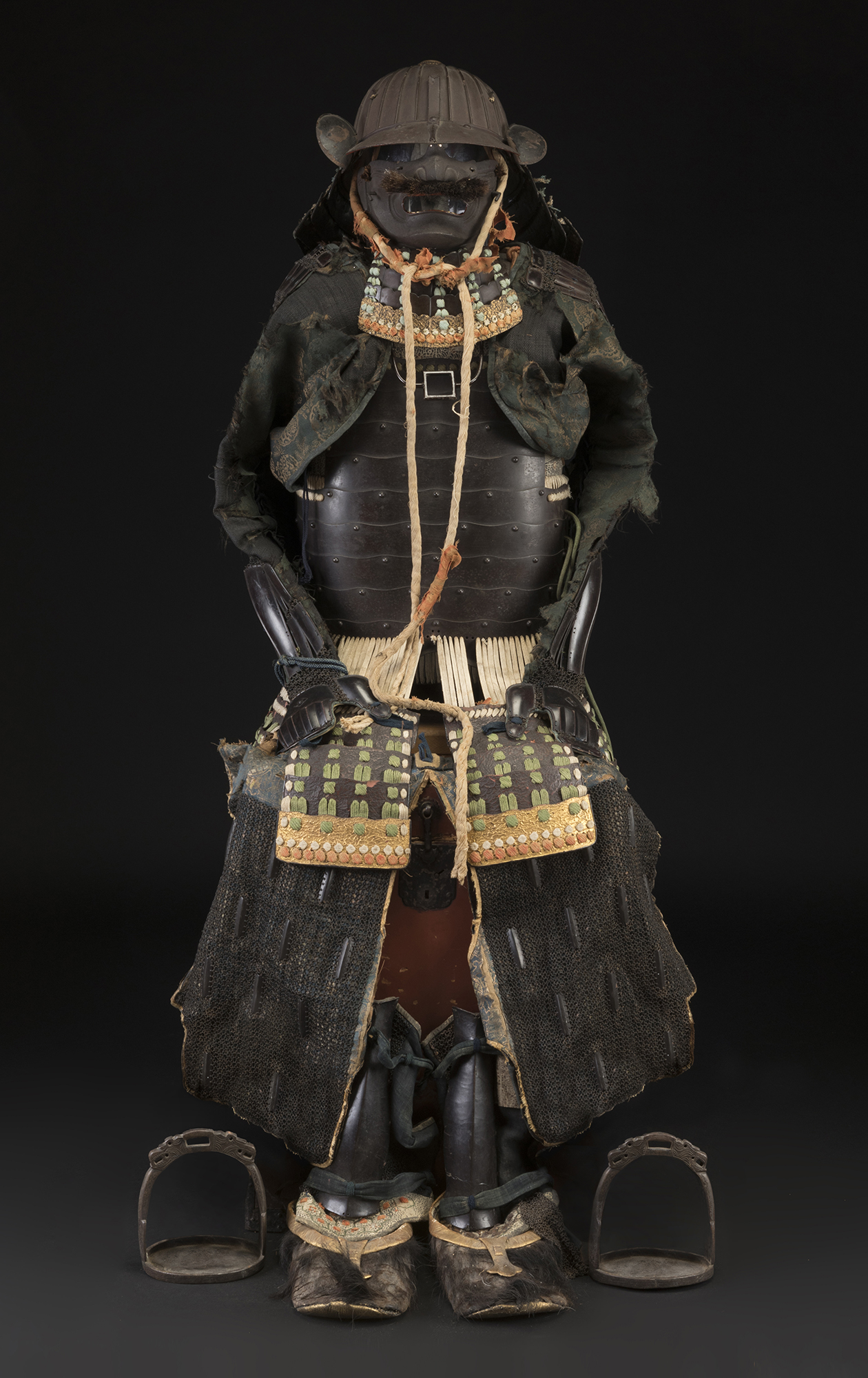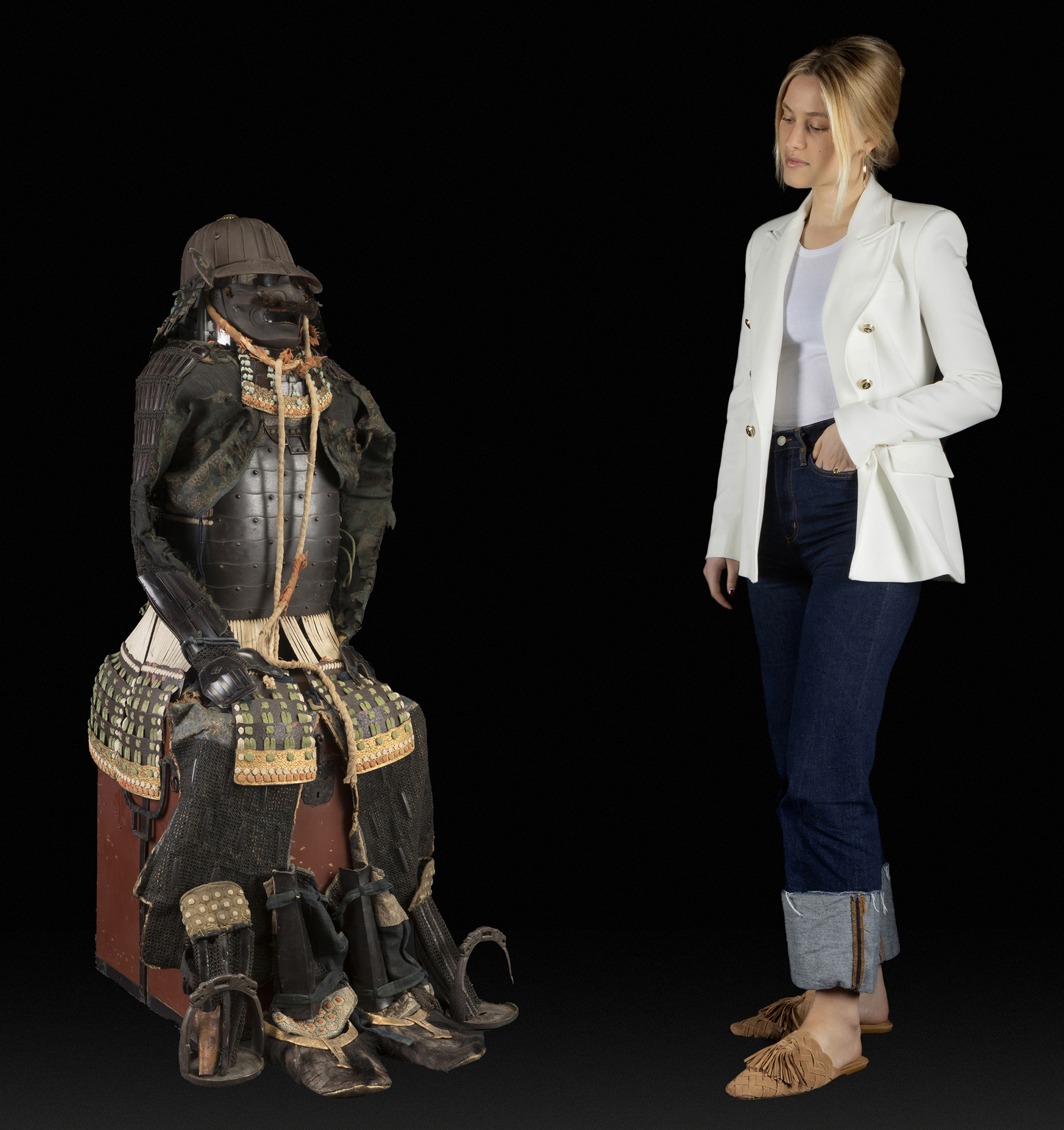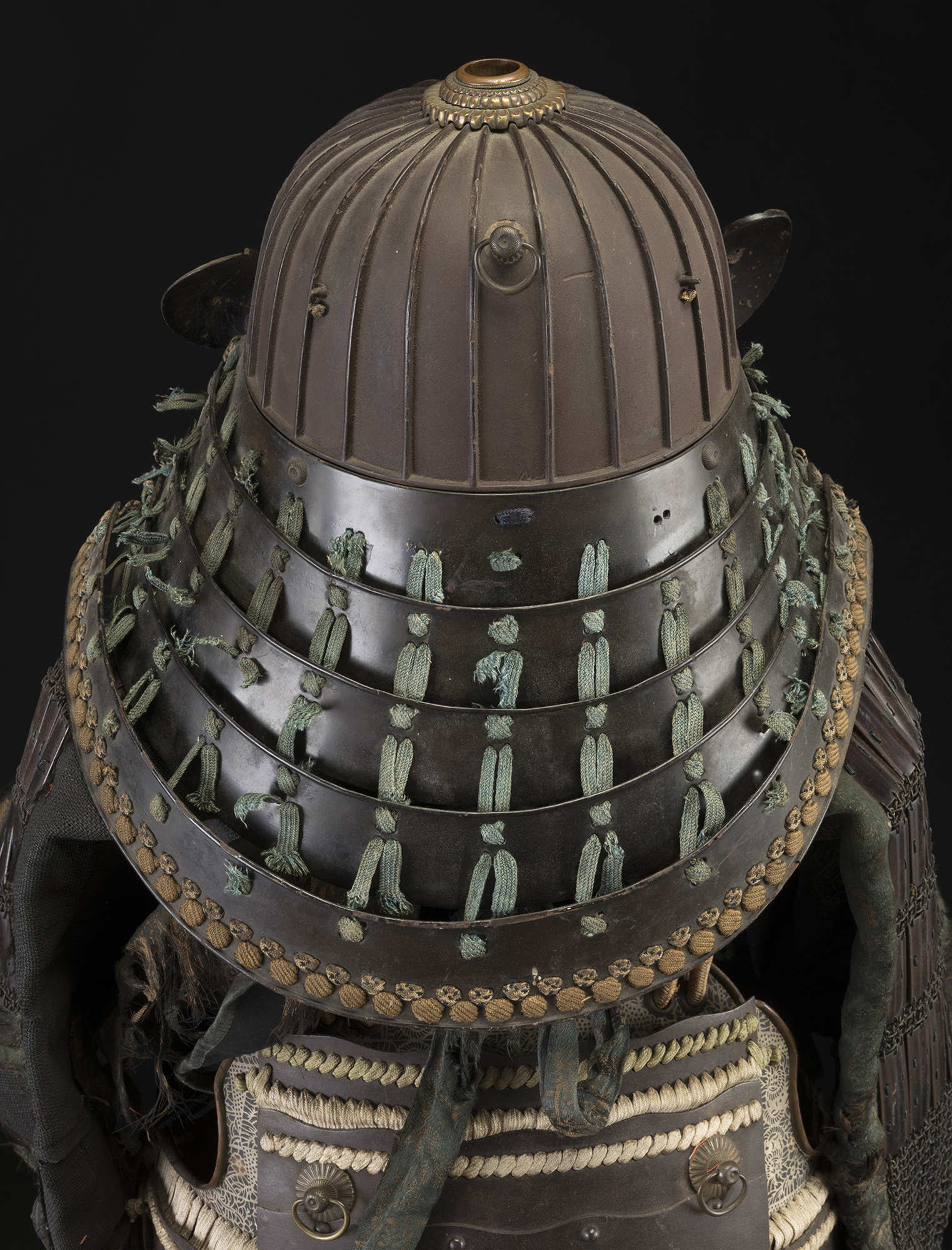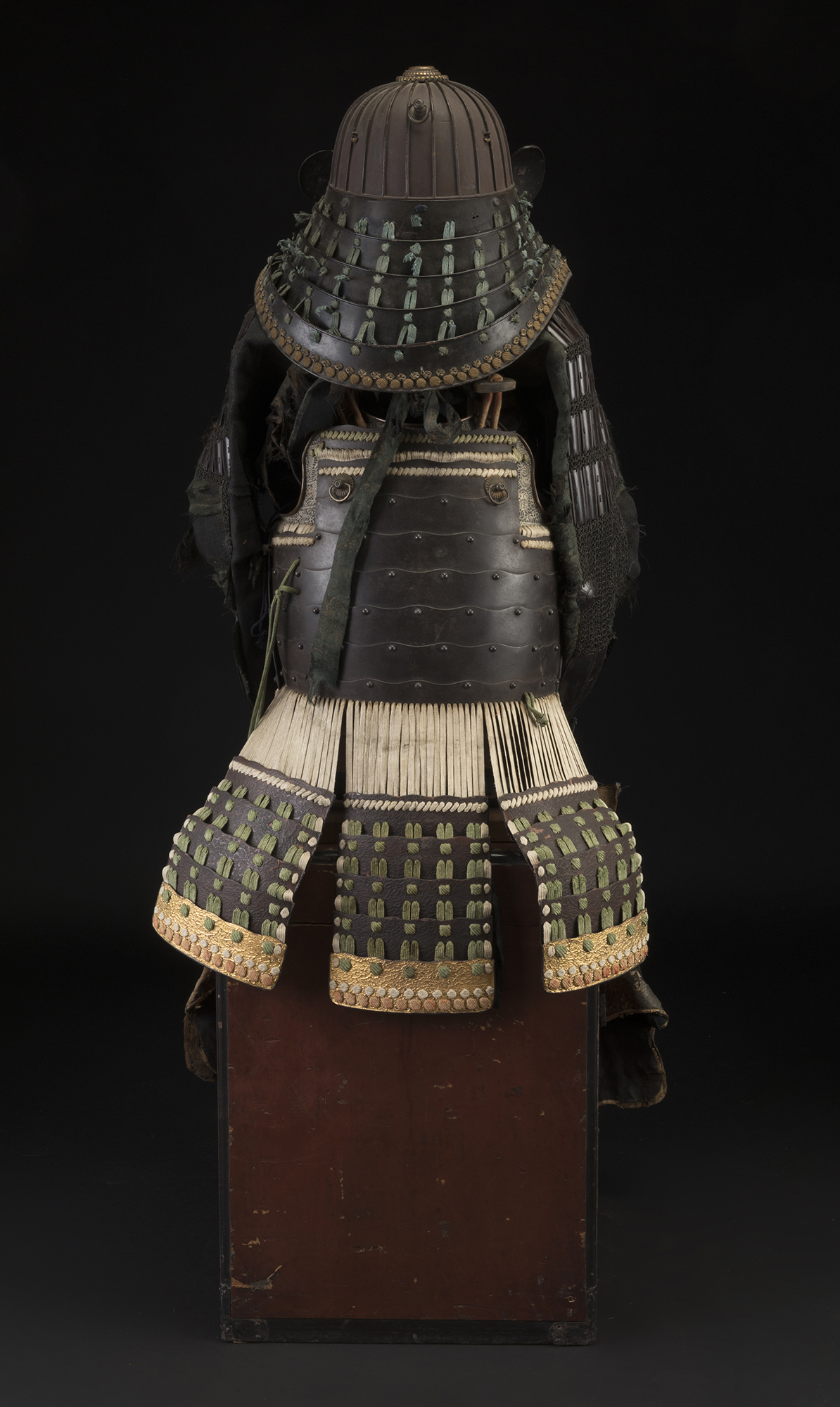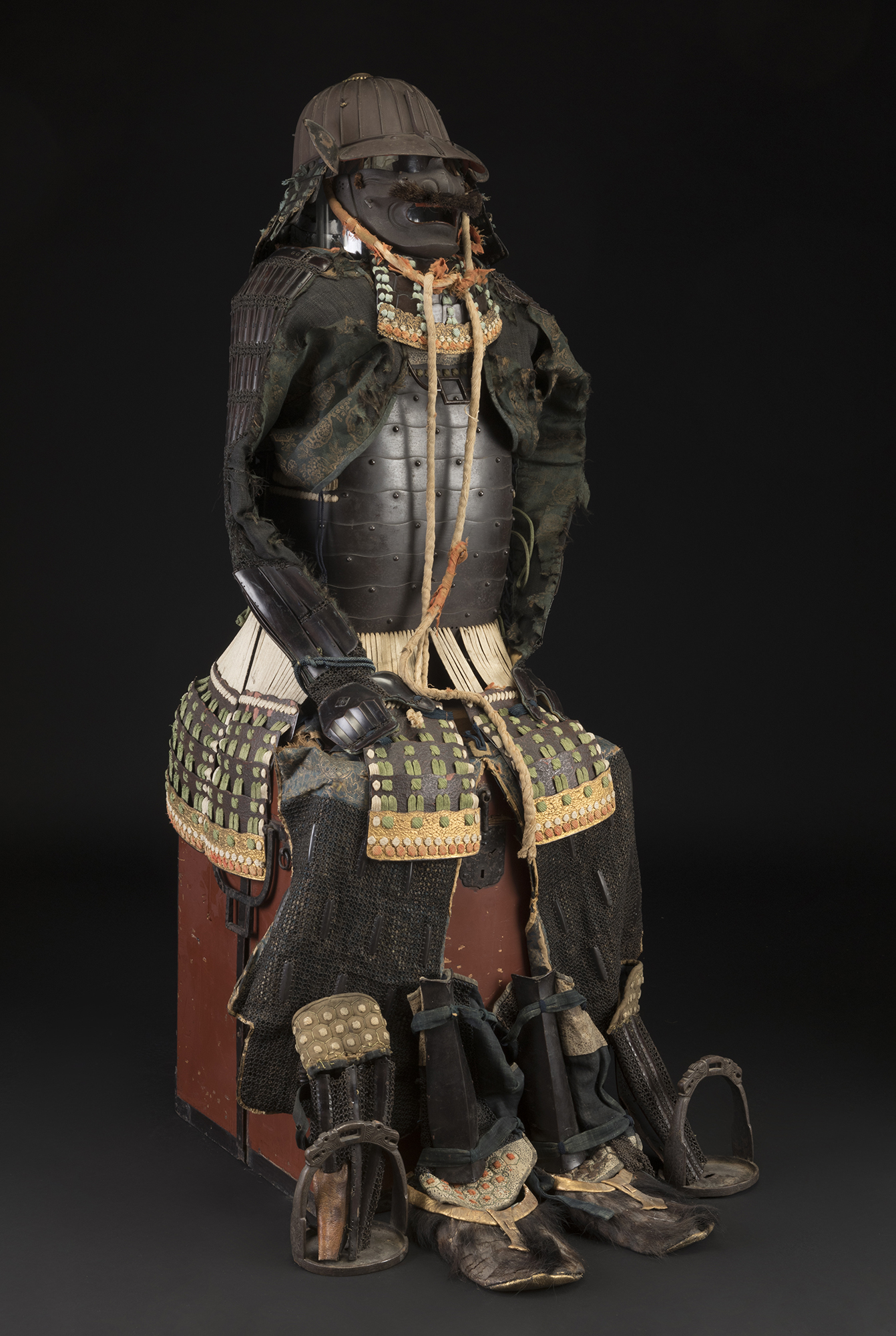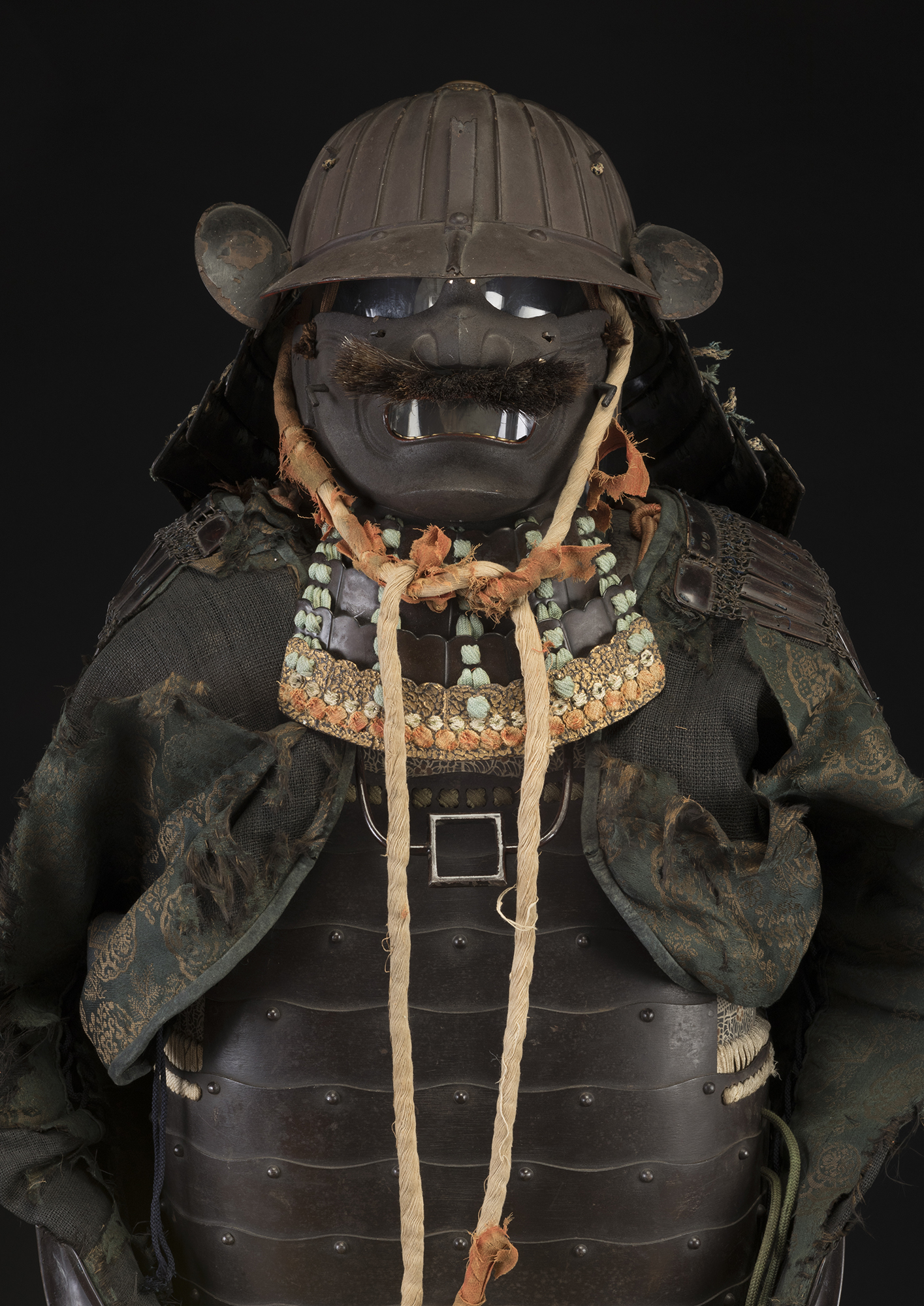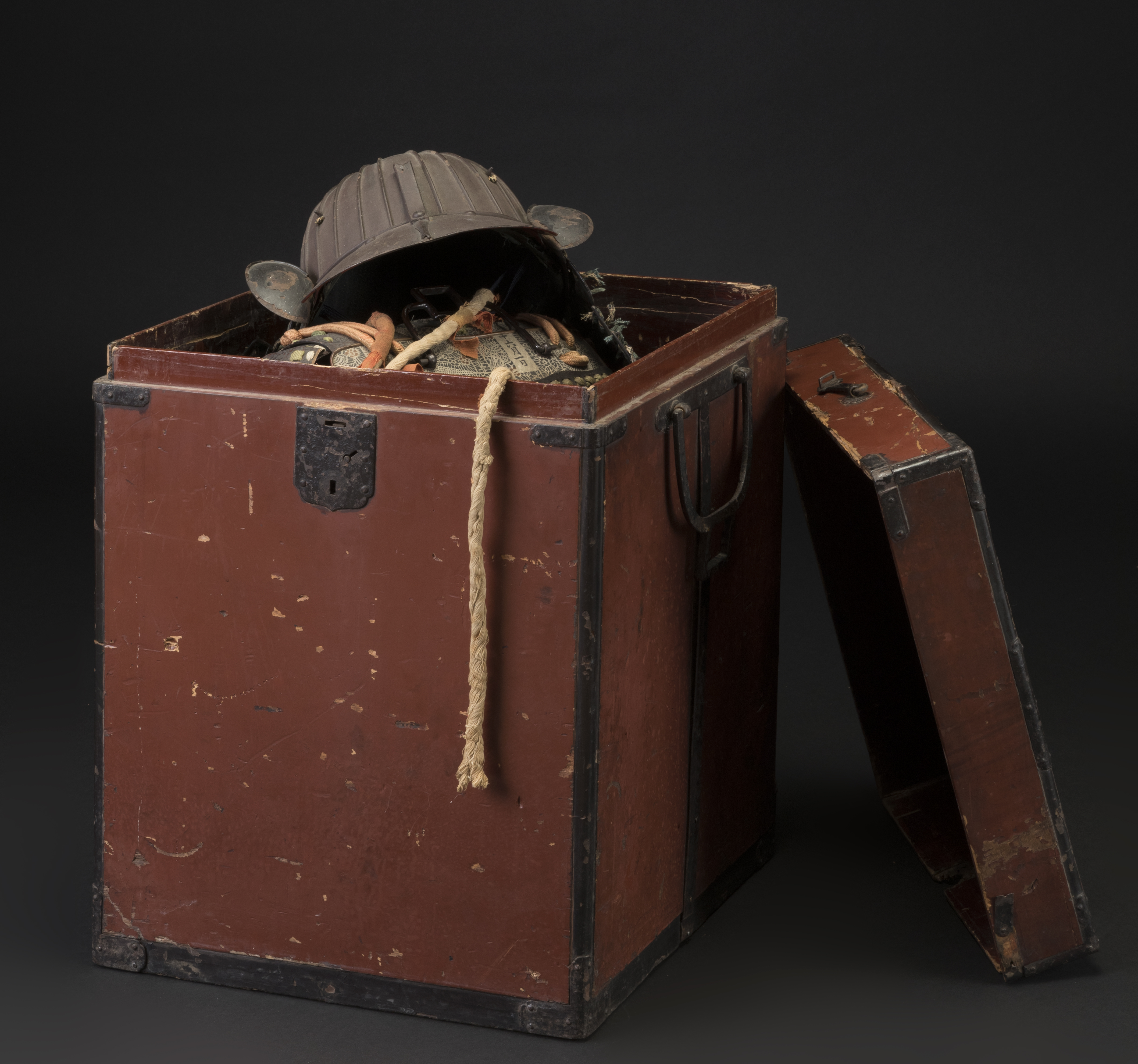1
Suit of samurai armour, Edo period, Japan, 18th century.Steel, leather, cloth and lacquered chain
Suit of samurai armour, Edo period, Japan, 18th century.
Steel, leather, cloth and lacquered chain mail.
Consisting of helmet, mask, breastplate, sleeves, thigh guard, shoulder pads, shin guards, shoes and stirrups.
It comes with its original polychrome wooden storage box.
It has slight faults and wear and tear due to use and the passage of time.
Measurements: 140 x 60 x 50 cm (mounted armour); 54 x 40 x 42 cm (box).
Japanese armour, regardless of its evolution over time, always tried to combine protection with mobility, so that the warrior had an acceptable freedom of movement. For this reason, the "gushoku-shi", the master craftsmen of this art, always sought materials that would allow this balance, such as metal and leather.
The armour we now present consists of a kabuto or steel helmet from which hangs a shikoro neck protector. The mempo (mask covering from nose to chin) is polychrome black and has a moustache. This was intended as facial armour designed in such a way that the heavy helmet could be tied and secured to it by several metal stakes. The breastplate, made of horizontal plates, is covered by a steel mesh, ornamented with embroidered cloth. On its front is the yodare-kake, which protects the fighter's throat. The sleeves (kote) and shin guards (suneate) are made of metal plates. The lower part of the armour consists of haidate or thigh protectors, which were tied around the waist. These combined cloth and small steel and/or leather plates of varying size and shape, usually bound together by chain-mail (kusari) and sewn to the cloth. This example is also accompanied by stirrups and Kogake, the weapon shoe of Japanese armour, designed to cover the foot of the Japanese warrior.
The samurai's interest in distinguished armour arose in the Edo period, a period considered peaceful, also known as the Era of Unbroken Peace (1603-1868). In this period, the absence of war led to less activity on the part of the samurai, who were, however, required to report regularly to the court of the Shogun or army commander. The catwalk or parade that they had to walk until they reached the commander gave rise to a desire to exhibit the samurai's armour as authentic works of art. Thus, the armour became a showcase for the arts of many craftsmen (embroiderers, blacksmiths, weavers, etc.).
At the end of the Heian period (794-1185), the first full armour as we know it today began to appear, made from sheets of iron bound together with strips of leather and silk cords, which again made it possible to increase mobility and lightness. In fact, the manufacture of armour became so complicated that by the 19th century it was considered an independent art, "odoshi-gei". Thus, in the 18th and 19th centuries, armour would include numerous variations designed to reflect the clan and rank to which the warrior wearing it belonged. Special mention should be made of the colours, not only because of their association with certain families but also because of their symbolic content. In fact, the colour white corresponds in Japanese culture to mourning, and if it appeared on a suit of armour it represented the conviction to give up one's life in battle. This progressive complication, however, generated considerable controversy, as the intricacy of the silk and leather weaves made it easy for enemy weapons and projectiles to get caught in them during battle, and their nooks and crannies could harbour mould and parasites.
Suit of samurai armour, Edo period, Japan, 18th century.
Steel, leather, cloth and lacquered chain mail.
Consisting of helmet, mask, breastplate, sleeves, thigh guard, shoulder pads, shin guards, shoes and stirrups.
It comes with its original polychrome wooden storage box.
It has slight faults and wear and tear due to use and the passage of time.
Measurements: 140 x 60 x 50 cm (mounted armour); 54 x 40 x 42 cm (box).
Japanese armour, regardless of its evolution over time, always tried to combine protection with mobility, so that the warrior had an acceptable freedom of movement. For this reason, the "gushoku-shi", the master craftsmen of this art, always sought materials that would allow this balance, such as metal and leather.
The armour we now present consists of a kabuto or steel helmet from which hangs a shikoro neck protector. The mempo (mask covering from nose to chin) is polychrome black and has a moustache. This was intended as facial armour designed in such a way that the heavy helmet could be tied and secured to it by several metal stakes. The breastplate, made of horizontal plates, is covered by a steel mesh, ornamented with embroidered cloth. On its front is the yodare-kake, which protects the fighter's throat. The sleeves (kote) and shin guards (suneate) are made of metal plates. The lower part of the armour consists of haidate or thigh protectors, which were tied around the waist. These combined cloth and small steel and/or leather plates of varying size and shape, usually bound together by chain-mail (kusari) and sewn to the cloth. This example is also accompanied by stirrups and Kogake, the weapon shoe of Japanese armour, designed to cover the foot of the Japanese warrior.
The samurai's interest in distinguished armour arose in the Edo period, a period considered peaceful, also known as the Era of Unbroken Peace (1603-1868). In this period, the absence of war led to less activity on the part of the samurai, who were, however, required to report regularly to the court of the Shogun or army commander. The catwalk or parade that they had to walk until they reached the commander gave rise to a desire to exhibit the samurai's armour as authentic works of art. Thus, the armour became a showcase for the arts of many craftsmen (embroiderers, blacksmiths, weavers, etc.).
At the end of the Heian period (794-1185), the first full armour as we know it today began to appear, made from sheets of iron bound together with strips of leather and silk cords, which again made it possible to increase mobility and lightness. In fact, the manufacture of armour became so complicated that by the 19th century it was considered an independent art, "odoshi-gei". Thus, in the 18th and 19th centuries, armour would include numerous variations designed to reflect the clan and rank to which the warrior wearing it belonged. Special mention should be made of the colours, not only because of their association with certain families but also because of their symbolic content. In fact, the colour white corresponds in Japanese culture to mourning, and if it appeared on a suit of armour it represented the conviction to give up one's life in battle. This progressive complication, however, generated considerable controversy, as the intricacy of the silk and leather weaves made it easy for enemy weapons and projectiles to get caught in them during battle, and their nooks and crannies could harbour mould and parasites.
10th October - Oriental Art
Sale Date(s)
Venue Address
General delivery information available from the auctioneer
Setdart offers Worldwide shipping
PICK UP IN ROOM: You can come and pick up your lots in our offices (Barcelona, Madrid or Valencia). At the moment of the withdrawal, you will be able to accept the current conditions of the lot by means of a document that you will sign.
YOU CAN SEND ANOTHER PERSON TO PICK UP: This person must present a signed authorization that you can find in our web page by accessing from BUY AT SETDART- LOGISTICS-DOWNLOAD AUTHORIZATION DOCUMENT. You can also send an e-mail with the requested data in AUTHORIZATION DOCUMENT to admin@setdart.com
Important Information
25% buyer´s premium
21% buyer´s premium at www.setdart.com
Terms & Conditions
The maximum period to pay the lots is 7 working days. You can pay either via bank transfer or with credit card through our platform www.setdart.com (we only accept VISA or Mastercard).
BUYER´S PREMIUM: 22% Hammer price + 21% VAT from the buyer´s premium
If your piece has more than 100 years, our Ministry of Culture requires an export certificate in order for the piece to leave the country. Note that if the piece goes inside the EU, there is no cost for the export certificate. If the piece goes outside the EU, there is a cost for the export certificate. You can find more information in our Ministry of Culture website: https://www.culturaydeporte.gob.es/en/cultura/patrimonio/exportacionimportacion/exportacion/tasas.html
INQUIRIES: admin@setdart.com
Setdart guides you through the entire process, from the time of award to the day you receive your lot. Our logistics team will be happy to manage your transport, and will advise you on the best shipping method with professionals from the sector used to handling works of art and jewelry.
WE OFFER WORLDWIDE DOOR TO DOOR SHIPPING
PICK UP IN ROOM: You can come and pick up your lots in our offices. At the moment of the withdrawal, you will be able to accept the current conditions of the lot by means of a document that you will sign.
YOU CAN SEND ANOTHER PERSON TO PICK UP: This person must present a signed authorization that you can find in our web page by accessing from BUY AT SETDART-LOGISTICS-DOWNLOAD AUTHORIZATION DOCUMENT. You can also send an e-mail with the requested data in AUTHORIZATION DOCUMENT to admin@setdart.com
SETDART IS NOT RESPONSIBLE FOR THE STATE OF THE PARTS ONCE THEY LEAVE OUR FACILITIES. MRW SHIPMENTS: Once the payment is made, your lot will be packed for shipment, the logistics department will send you an e-mail notifying you of the day it leaves our warehouse, changes of address cannot be made after receiving this e-mail.
INSURANCE INCIDENTS: Coverage for the value of the auction up to 3000 ? per shipment, if the value of the auction is higher, Setdart will send you a quote including the additional insurance. The insurance company WILL NOT BE RESPONSIBLE FOR THE SHIPMENT THAT EXCEEDS THAT AMOUNT AND IS NOT FULLY INSURED. MRW INCIDENTS: Maximum notification 48 hours after receipt, after which the insurance company WILL NOT BE RESPONSIBLE AND NO CLAIMS WILL BE ACCEPTED.
E-MAIL LOGISTICS: logistica@setdart.com
PICK UP YOUR MESSAGES: You can send your own messaging, prior notice via e-mail that your shipment is ready, please note 3 or 4 days in advance. This type of shipment is packaged so Setdart will provide you with a quote.
EXPENSES FOR STORAGE: We inform you that if the purchased lot is not picked up within a month, you will be charged 30€ per week per lot. Setdart Online S.L., owner of the web site "setdart.com", "setdart.net" and "setdart.org", acts as a company of Spanish nationality inscribed in the Volume 36955, sheet 182, page B-293056 of the Mercantile Registry, with registered office at Calle Aragó















